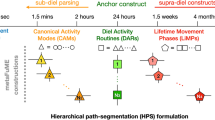Abstract
This report describes an application of continuous spatial models to freight movements in Greater London. Continuous spatial models are fitted to data on the densities of generation and attraction of the freight assuming that the density is dependent on the distance from the centre of the area. The fit is measured using regression analysis and the results are examined. The graphs of the densities against the distance from the centre suggest an exponential relationship, and Clark's model is fitted to the data. The model fits fairly well to the data on densities for most groups of commodities. The correlation between the density and the distance is stronger for attraction than for generation in most groups of commodities.
Similar content being viewed by others
References
Ajo, R. (1965). “On the structure of population density in London's field,” Acta Geographica (Helsinki) 18: 1–17.
Angel, S. and Hyman, G. M. (1976). Urban Fields: A Geometry of Movement for Regional Science. London: Pion Ltd.
Atkins Planning (1975). “Swindon Freight Study: collection of data and construction of computer model,” TRRL Report SR158UC. Crowthorne: Transport and Road Research Laboratory.
Blumenfeld, D. E. (1977). “Modeling the joint distribution of home and workplace locations in a city,” Transp. Sci. 11: 307–337.
Blumenfeld, D. E. and Weiss, G. H. (1974). “Some radial and direction dependent models for densities of homes and workplaces,” Transp. Res. 8: 149–155.
Clark, C. (1951). “Urban population densities,” J. Roy. Statist. Soc. Series A, 114: 490–496.
Fryer, J. A., Hassell, B. B., Ness, M.P. and Stroud, A.A. (1975). “Greater London Transportation Survey: 2. Processing the data,” Traffic Eng. & Control 16: 270–272, 286.
MacBriar, I. (1977). “Some fundamental characteristics of those means of transport used for scheduled passenger service in town, “Ph. D. Thesis, University of Newcastle upon Tyne.
Maejima, T. (1971). Modelling the trip distribution of freight movements — 1. Annual Report of Researches on Roads, Ministry of Construction, Public Works Research Institute, Japan (in Japanese).
Maejima, T. (1972). Modelling the trip distribution of freight movements — 2. Annual Report of Researches on Road. Ministry of Construction, Public Works Research Institute, Japan (in Japanese, a brief summary paper is available in English).
Mogridge, M. J. H. and Murchland, J. D. (1976). “Simplified transportation models.” PTRC Summer Annual Meeting, University of Warwick, England, Seminar N, P142, 190–199. Planning and Transport Research and Computation (International) Co. Ltd., London.
Papageorgiou, G. J. (1971). “A theoretical evaluation of the existing population density gradient functions,” Economic Geography 47: 21–26.
Sherratt, G. G. (1960). “A model for General-Urban Growth,” pp. 147–159 in Management Sciences, Models and Techniques, Vol. 2. C. Churchman and M. Verhulst, eds., (Proceeding of the Sixth International Meeting of the Institute of Management Sciences, Paris, September 1959). Oxford: Pergamon Press.
Smeed, R. J. (1963). “Road development in urban areas,” J. Inst. Highw. Eng. 10: 5–26.
Smeed, R. J. (1971). “The effect of the design of road network on the intensity of traffic movement in different parts of a town with special reference to the effect of ring roads,” Technical Note 17, (Proceedings of the Tewksbury Symposium, University of Melbourne, Australia, July 1970.) London: Construction Industry Research and Information Association.
Smeed, R. J. (1977). “Traffic in a linear town.” Proceedings of the Seventh International Symposium on Transportation and Traffic Theory, Kyoto, Japan, August 1977.
Tanner, J. C. (1961). “Factors affecting the amount of travel,” Road Research Technical Paper No. 51. London: Her Majesty's Stationery Office.
Tanner, J. C. (1972). “A strategic model for urban transport planning.” Proceedings of the Fifth International Symposium on the Theory of Traffic Flow and Transportation.
Weald, D. E. (1975). “Greater London Transportation Survey: 1. Organization and management of the surveys,” Traffic Eng. & Control 16:212.
Author information
Authors and Affiliations
Rights and permissions
About this article
Cite this article
Maejima, T. An application of continuous spatial models to freight movements in Greater London. Transportation 8, 51–63 (1979). https://doi.org/10.1007/BF00149851
Issue Date:
DOI: https://doi.org/10.1007/BF00149851




